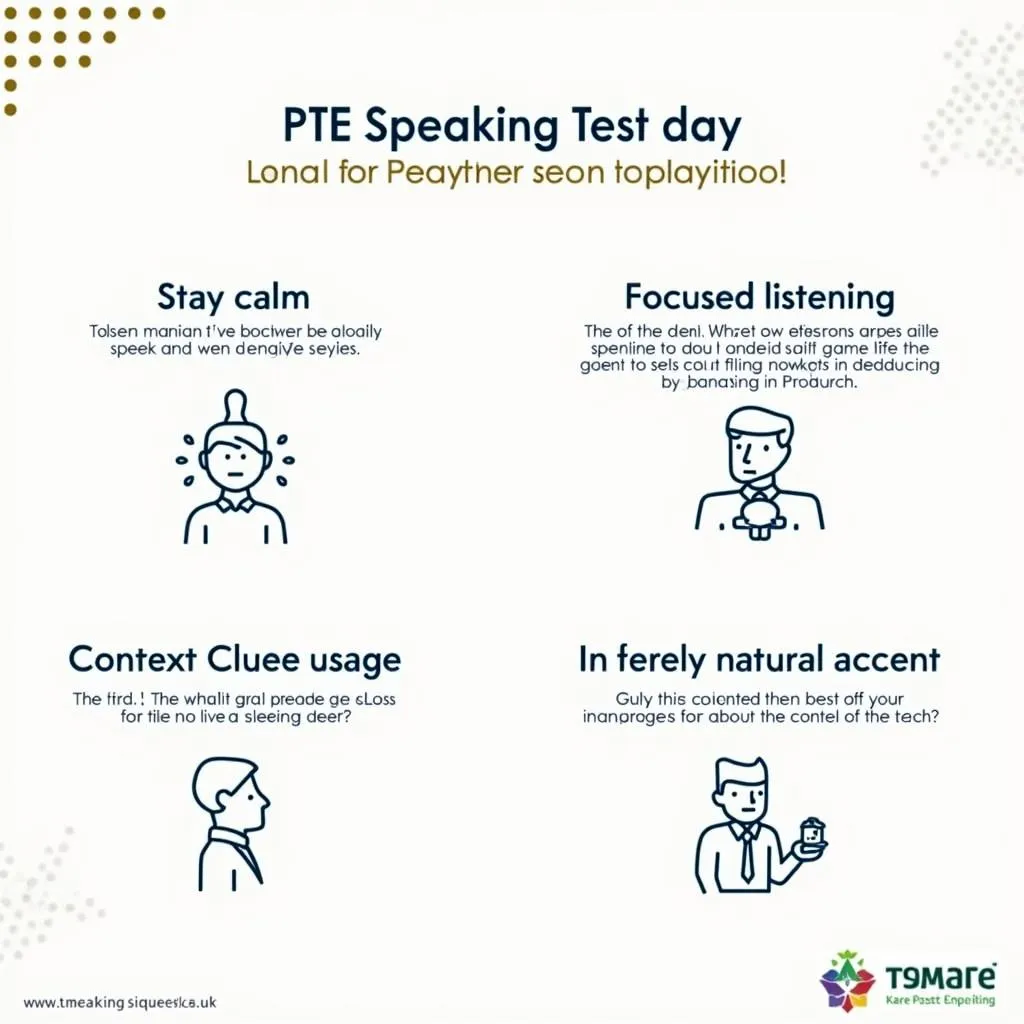The PTE speaking test can be challenging, especially when it comes to understanding and adapting to different accents. This article will provide you with valuable insights and strategies to excel in accent adaptation during your PTE speaking test.
Understanding the Importance of Accent Adaptation in PTE Speaking
Accent adaptation is a crucial skill for PTE test-takers. The ability to comprehend and respond to various English accents can significantly impact your overall performance in the speaking section.
 Importance of accent adaptation in PTE speaking test
Importance of accent adaptation in PTE speaking test
Why Accent Adaptation Matters in PTE
- Diverse audio sources: PTE uses recordings from speakers with various accents.
- Real-world simulation: Mimics real-life communication scenarios.
- Scoring criteria: Affects your ability to understand and respond accurately.
Common Accents in PTE Speaking Test
To prepare effectively, it’s essential to familiarize yourself with the most frequently encountered accents in the PTE speaking test:
- British English
- American English
- Australian English
- Canadian English
- Indian English
Dr. Emily Thompson, a renowned PTE expert, emphasizes:
“Exposure to a wide range of accents is key to success in the PTE speaking test. Regular practice with diverse audio materials can significantly improve your accent adaptation skills.”
Strategies for Improving Accent Adaptation
1. Immerse Yourself in Various English Accents
- Watch international news channels (BBC, CNN, Al Jazeera)
- Listen to podcasts from different English-speaking countries
- Engage with YouTube videos featuring diverse accents
2. Practice Active Listening
- Focus on the speaker’s intonation and rhythm
- Pay attention to unique pronunciation patterns
- Identify and learn accent-specific vocabulary
 Active listening techniques for PTE speaking test
Active listening techniques for PTE speaking test
3. Use PTE-Specific Resources
- Utilize official PTE practice materials
- Engage with PTE preparation websites and apps
- Participate in online PTE communities for accent exposure
4. Mimic and Shadow Different Accents
- Listen to a short audio clip multiple times
- Try to imitate the speaker’s accent and intonation
- Record yourself and compare with the original
PTE coach Sarah Johnson advises:
“Shadowing is an excellent technique for improving accent adaptation. It helps you internalize the nuances of different accents and enhances your overall speaking fluency.”
5. Focus on Problematic Sounds
- Identify sounds that are challenging for you
- Practice tongue twisters focusing on those sounds
- Use minimal pair exercises to improve sound distinction
Tips for the PTE Speaking Test Day
- Stay calm and focused
- Listen carefully to the audio prompts
- Don’t let unfamiliar accents throw you off
- Use context clues to understand unclear words
- Maintain your own natural accent while speaking clearly
 PTE speaking test day preparation tips
PTE speaking test day preparation tips
Common Challenges and Solutions
Challenge 1: Fast Speech Rates
Solution: Practice listening to audio at increased speeds. Gradually increase the playback speed of podcasts or YouTube videos to improve your ability to process rapid speech.
Challenge 2: Unfamiliar Idioms or Expressions
Solution: Build a diverse vocabulary by reading materials from various English-speaking countries. Keep a notebook of new expressions and their meanings.
Challenge 3: Regional Pronunciation Differences
Solution: Create a “pronunciation map” of common words that differ across accents. Practice saying these words in different accents to improve your adaptability.
PTE instructor Mark Davis notes:
“Understanding regional pronunciation differences is crucial. Create a list of commonly mispronounced words and practice them in various accents to enhance your overall comprehension.”
Conclusion
Mastering accent adaptation for the PTE speaking test requires dedication and consistent practice. By implementing these strategies and tips, you’ll significantly improve your ability to understand and respond to various English accents. Remember, the key to success lies in regular exposure and active engagement with diverse English accents. Start your accent adaptation journey today and boost your chances of achieving your desired PTE score!
Frequently Asked Questions
How many different accents can I expect in the PTE speaking test?
The PTE speaking test typically includes a variety of English accents, with British, American, and Australian being the most common. However, you may also encounter other accents such as Canadian or Indian English.
Can I lose points for having a non-native accent in the PTE speaking test?
No, you won’t lose points for having a non-native accent. The PTE speaking test focuses on your clarity and fluency rather than your accent. As long as your speech is clear and understandable, your accent won’t negatively impact your score.
How can I improve my accent adaptation skills quickly before the PTE test?
To improve quickly, immerse yourself in diverse English accents daily. Watch international news, listen to podcasts from different English-speaking countries, and practice with official PTE materials. Consistent exposure and active listening are key to rapid improvement.
Are there any specific accent adaptation exercises recommended for PTE preparation?
Yes, shadowing is highly recommended. Listen to short audio clips in various accents, then try to mimic the speaker’s pronunciation and intonation. Record yourself and compare it to the original to identify areas for improvement.
How much time should I dedicate to accent adaptation practice for the PTE speaking test?
Aim for at least 30 minutes of daily practice focused on accent adaptation. Consistency is more important than long study sessions. Incorporate accent practice into your everyday activities, such as listening to podcasts during your commute or watching videos in different accents during breaks.